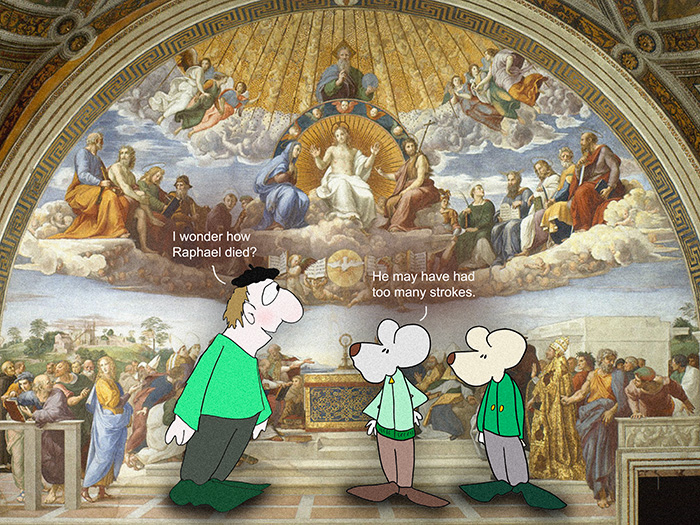I love to travel back through time and wonder about how life must have been so long ago. The players in the world were our ancestors. Yes, after all, they are the ones who started this mess. But so many times throughout this history of Earth, there have been notable people and remarkable occurrences. Like, those folks that figured out the deal about putting water and coffee beans together. Or the person who decided we needed ping pong balls.
Anyway, art is one of those historical niches I love to explore. At some point, a person had to decide to mash up some berries and start spreading them on a cave wall, fashioning things like wooly mammoths with long tusks, and bulls with big horns. And art was born.
Great artists came along.
And one of them was born on this date, April 6, 1483. His full name was Raffaello Sanzio da Urbino. But everyone knew him as Raphael, a master painter, and architect.
As a master artist of the High Renaissance, Raphael is best known today for his “Madonnas” and for his large body of work in the Vatican in Rome. This would include one of his best-known works, ‘The School of Athens.’
He was named among the “Trinity” of great masters for that period, which included Michelangelo and Leonardo da Vinci. And, of course, our Raphael. I’ll tell you, though, he always seems to be the afterthought when it comes to the other two and their notoriety. The third wheel. The back burner. But Raphael was better than good.
Isn’t it funny when we look back at history and how those “great” people started out? It always seems that their beginnings were rocky, or tragic, or disparaging.
Such was the case with Raphael. He was born in Urbino, Italy. At the time, Urbino was a cultural center that encouraged the Arts. Which proved to be conducive for young Raphael. But his mom died when he was eight. His dad died three years later.
Yet, before he died, his father ( Giovanni Santi ) was a painter for a Duke. A court painter. And dear old dad taught his boy how to paint. He showed him the basic techniques. Not only that, he exposed him to the principles of humanistic philosophy at the Duke of Urbino’s court.
In 1494, when his dad died, the 11-year-old Raphael took over the daunting task of managing his father’s workshop. His success in this role quickly surpassed his father’s. He was soon considered one of the finest painters in town.
Over the years, he continued to better himself, studying the works of others. By the early 1500s — from 1504 through 1507 — Raphael produced a series of “Madonnas,” which favored and expanded on da Vinci’s works.
Raphael painted an additional fresco cycle for the Vatican in the years to come. He then shifted his focus to architectural work. The Pope named him the lead architect. But, his work was not limited to religious buildings. It also extended to designing palaces.
On April 6, 1520, Raphael’s 37th birthday, he died suddenly and unexpectedly of mysterious. He passed while in Rome, Italy. He had been working on his largest painting on canvas at the time of his death. The work was called “The Transfiguration.” When his funeral mass was held at the Vatican, Raphael’s unfinished Transfiguration was placed on his coffin stand. Raphael’s body was interred at the Pantheon in Rome, Italy.
I’m always curious when someone dies mysteriously at such a young age, even for back then. First, they said it must have been syphilis, but somehow that was proven wrong. Now, they speculate it may have been pulmonary disease and bloodletting. No matter, I suppose.
One day a master in the art world. And then next, a part of history. Nonetheless, he left behind a world of his creation, making this world a changed and better place.
==========
“If you could say it in words, there would be no reason to paint.”
― Edward Hopper
===========
“Every now and then one paints a picture that seems to have opened a door and serves as a stepping stone to other things.”
― Pablo Picasso
===========
“It is not your paintings I like, it is your painting.”
― Albert Camus
===========
=
=
=
=
=
=
=
“Lets build a happy little cloud.
Lets build some happy little trees.”
― Bob Ross
===========
I like your style, but can I call you Ralph, for short?
